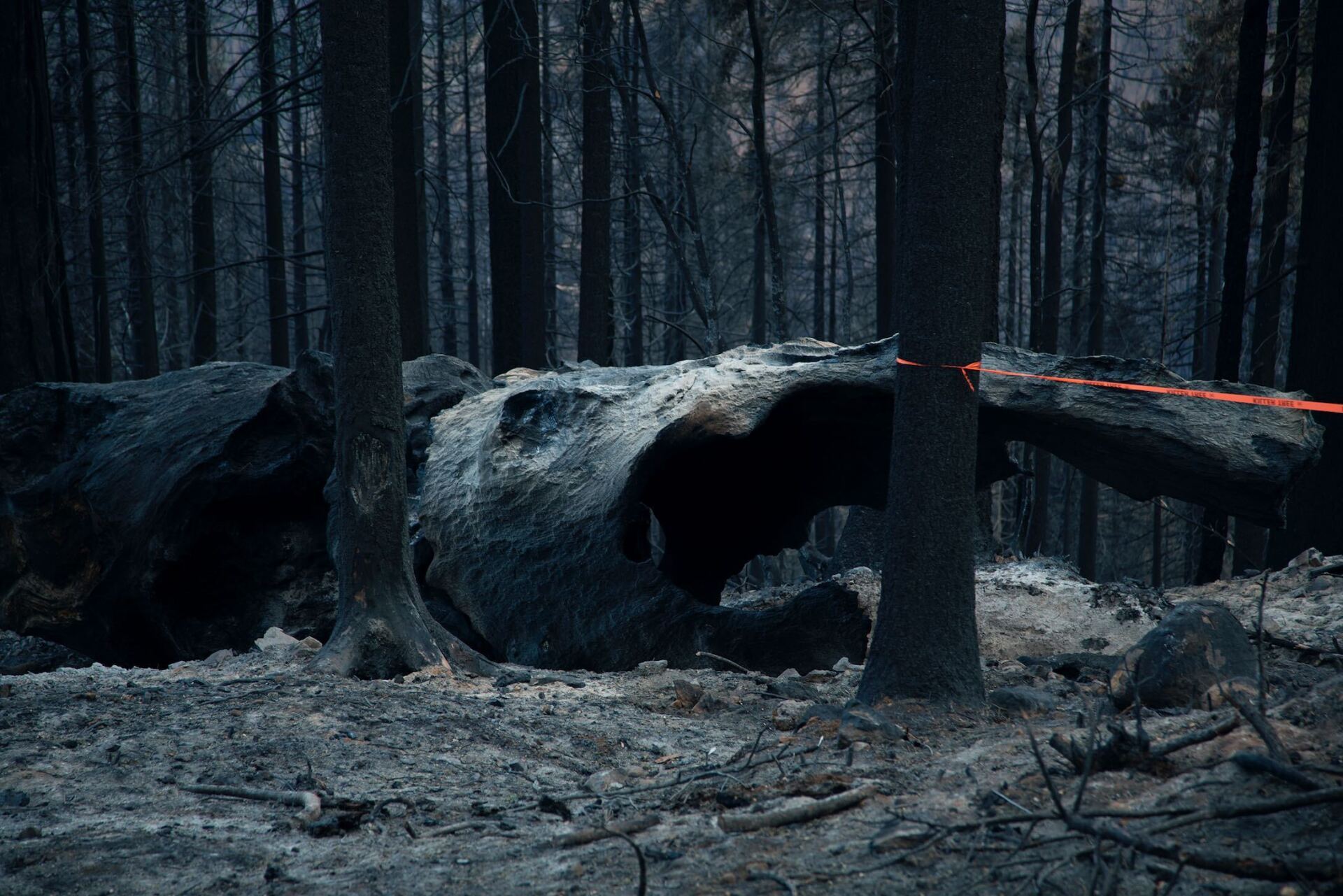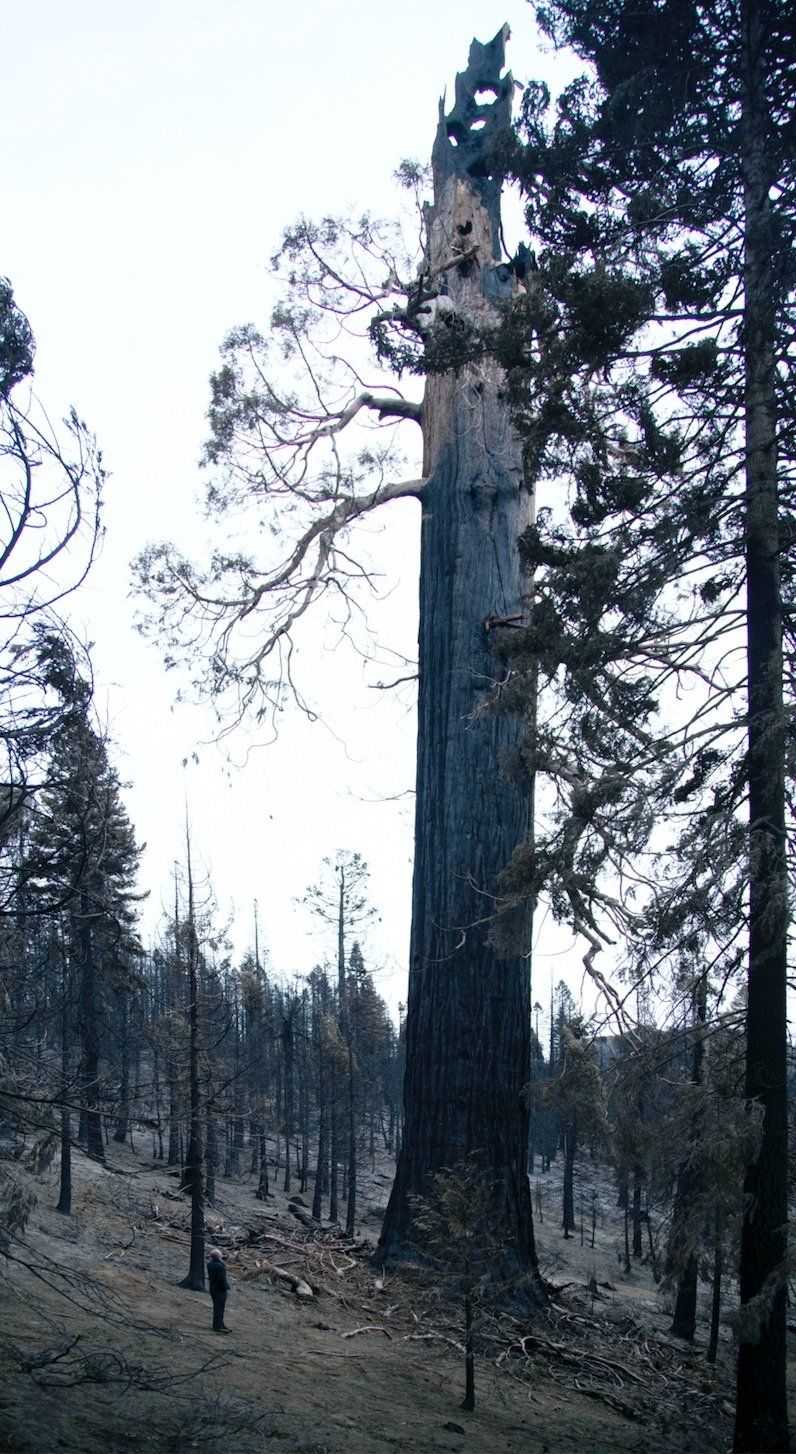Environment & Art - 13 July 2022
Uta Kögelsberger, Charles Wollaston Award Winner
about CULL and @Fire_Complex
Exclusive Interview
German version below

CULL - carcass - ©Uta Kögelsberger
Düsseldorf, 13 July 2022: The £25,000 Charles Wollaston Award for "most outstanding work has been awarded to artist Uta Kögelsberger for her video work CULL in the Royal Academy's 254th Summer Exhibition. Previous winners of the award include photographer Wolfgang Tillmanns, Anselm Kiefer and Yinka Shonibare. Alethea Magazine obtained an exclusive interview from the artist.
CULL follows the mammoth task of cleaning up after the devastating effects of the Castle Fire, which destroyed 174000 acres of the Sequoia National Forest in California, including an estimated 14% of the world's redwood population.
CULL is embedded in Uta Kögelsberger's ongoing project Fire Complex, found on Instagram at @Fire_Complex.
Fire Complex began when the artist observed firefighting crews removing dangerous trees. She was shocked to see hundreds or thousands of years of history and knowledge wiped out in seconds. She decided to document the work. She quickly realised how important it was that these works were shown directly in public spaces and not just in galleries. After its beginnings on Instagram, CULL and @Fire_Complex were shown on billboards in London, then across the UK on the occasion of COP 26. The video work, now on display at the Royal Academy, was finally shown in Los Angeles.
The rest of Fire Complex is now, of course, about reforestation campaigns, and happily we can report that over 6100 trees have already been planted. The artist is also constantly developing @Fire_Complex. Readers can keep up to date with the progress of the project on Instagram.
Uta Kögelsberger is happy with her task and says
the planet needs systemic change, but people don't have the luxury of waiting for it.

Video Still-Cull-Five Channel Video Installation©Uta Kögelsberger
Alethea Magazine: How did you find out about the Castle Fire?
Uta Kögelsberger: I had scheduled to make a work about the plight of Sequoia National Forest before the fires happened andknew about the Castle Fire a month before it burned through the Alder Creek Grove and through Sequoia Crest. The fire was started by a lightning strike 15 miles away from human habitation. Because it is so prohibitively difficult to get permits for controlled burns, natural wildfires are now often initially left to burn. Fire has always been a natural part of the ecosystem in California, but what is so disastrous is their unprecedented severity. Fire Complex addresses the multifaceted underbelly of this new condition on Instagram @fire_complex.
Alethea Magazine: Cull is part of your project Fire Complex. How was Fire Complex started and how far have you come with it?
Uta Kögelsberger: Fire Complex started when I first visited the area after the fires. The strike teams had already been brought in to remove hazard trees. Watching the removal of these trees was like seeing hundreds - sometimes thousands - of years of history and knowledge being wiped out in a matter of seconds. It was such a literally and metaphorically shattering experience to watch what was left of these majestic once living trees come crashing to the ground, like dead carcasses, sometimes falling with such force that the earth beneath them shakes. This is when I knew that I wanted to focus on the clear up process after the wildfires.
It then became clear very quickly how important it wasfor this body of works to be shown directly in the public realm. It needed to reach beyond the gallery walls. After its early days as a project on Instagram, Fire Complex has been shown on digital and paper billboards in the London and in a flyposting campaign on the occasion of COP 26 across the UK. The video work that is now on view at the Royal Academy was first shown on massive digital screen on the front of ahigh-rise building in Downtown LA and as a series of oversized billboard installations in Hollywood. These works in the urban environment brought the scale of the disaster into focus. At the same time, I staged a billboard performance in which all the stumps left over in the community after the clear up process were billboarded on top of one another, one layer of history drowning out the next. I should also mention that the presentations of the work in the public realm included QR codes that linked people back to information about how to support organisations that are actively engaged in forest regeneration.
The other aspect of Fire Complex consists of a community-based replanting effort that I initiated in collaboration with Forest Services, Cal Fire, Archangel Ancient Tree archive, the communities of Sequoia Crest, Alpine Village and Cedar Slope, and volunteers from the Rotary Club. Together have replanted over 6100 saplings. This effort is now an ongoing aspect of Fire Complex. On Instagram the project continues@fire_complex, to disseminates information about the complexities around fire prevention and management and to update people about new developments of the project.
Fire Complex is a body of works that is going to keep growing and changing in response to the new contexts it appears in. I am now starting to think about the next stages of this work. Whereas the first effort looked primarily at the ecological impact of this crisis I am starting to now look more closely at the human impact.
Alethea Magazine: How do you feel about receiving the Royal Academy Charles Wollaston Award?
Uta Kögelsberger: It’s an amazing public recognition of the work to win one of the most prestigious prizes for artists in the UK;A fantastic celebration of this project; and also the much needed recognition of the urgency of the situation in our forests.
Alethea Magazine: What do you see as the role of art in the environmental movement?
Uta Kögelsberger: Art can engage us in ways that straight facts sometimes can’t. It can get under your skin. It stays with you. It’s part of a process of sensing and sense-making. It takes more than logic to fully understand something. Yes, artit is an intellectual engagement but if it was only that then it would not be nearly as powerful as it can be. Brining these climate issues to people in ways that establish new connections and new forms of engagements is one thing that art can do. Also, it is hard to classify us artists, the people who make art, as belonging to a specific group of people or has having a specific agenda. I think that ‘rogueness’ is what puts us at such an advantage when it comes to bringing different people together.
Alethea Magazine: Can you tell me the message of your work?
Uta Kögelsberger: The discrete strands of Fire Complex bring together so many different languages and forms of engagement it would be reductive to reduce it to a single message.
But as a human being living in the 21st century I would say: Stop thinking about what the world can do to help you, but instead think of what you can do to help the world. We need systemic change to happen, but we do not have the luxury to wait for it. We are all responsible for the future of the whole planet.
Alethea Magazine: Dear Ms. Kögelsberger, thank you very much for this interview.
The interview was conducted by C. Mauer
13 July 2022

CULL by Uta Kögelsberger - favorite tree ©Rita Kögelsberger
ALETHEA recommends
13 July 2022

Art Calendar - 3 July 2022
Olafur Eliasson at
Palazzo Strozzi
22 September 2022 - 22 January 2023. The Fondazione Palazzo Strozzi in Florence announces a solo exhibition by international artist Olafur Eliasson. This exhibition will be the Icelandic-Danish artist's most extensive exhibition in Italy to date. Since 2006, the Palazzo has been the seat of the Fondazione Palazzo Strozzi di Firenze, an independent public-private cultural foundation. It regularly hosts exhibitions of Italian and international art.
Olafur Eliasson
Dimmable Firefly Double Polyhedron Sphere Experiment, 2020 - Photo: Jens Ziehe
Courtesy of of the artist; neugerriemschneider, Berlin; Tanya Bonakdar Gallery, New York
© 2020 Olafur Eliasson

Düsseldorf - 6 July 2022
Open Call - INVICTUS GAMES DÜSSELDORF 2023 is looking for volunteers!!!
"A HOME FOR RESPECT."
Volunteers are an integral part of the Invictus Games. They are there to welcome all guests and athletes on site and help them find their way around the Merkur Arena and Düsseldorf and feel welcome. They accompany the teams throughout the Games, whether in shuttle buses, in the catering team or during the competitions.
©IG23 Harry Duke of Sussex

10 July 2022 Fashion / Art
Maison Valentino The Beginning Haute Couture FW 22 23 - 8 July 2022, Spanish Steps in Rome. "Beauty comes from harmony" says Pierpaolo Piccioli, referring also to the harmony of society. The concept: Pierpaolo Piccioli wants to bring the people and ideas that were once on the margins into focus, to make them protagonists. An idea that expands the spectrum of beauty.
©Courtesy of Valentino
Deutsche Version des Interviews mit Uta Kögelsberger
Environment & Art - 13 Juli 2022
Uta Kögelsberger , Charles Wollaston Award Preisträgerin über
CULL und @Fire_Complex
Exklusives Interview
Der mit 25 000 £ dotierte Charles Wollaston Award für das "herausragendste Werk wurde der Künstlerin Uta Kögelsberger für ihre Videoarbeit CULL in der 254. Sommerausstellung der Royal Academy verliehen. Zu den früheren Gewinnern des Preises gehören unter anderem der Fotograf Wolfgang Tillmanns, Anselm Kiefer und Yinka Shonibare. Alethea Magazine erhielt ein exklusives Interview von der Künstlerin.
CULL verfolgt die gigantische Aufgabe der Aufräumarbeiten nach den verheerenden Auswirkungen des Castle Fire, das 174000 Acres des Sequoia National Forest in Kalifornien zerstört hatte, darunter schätzungsweise 14% des weltweiten Mammutbaumbestands.
CULL ist eingebettet in Rita Kögelsberger’s laufendes Projekt Fire Complex, auf Instagram zu finden unter @Fire_Complex.
Fire Complex begann, als die Künstlerin die Löschmannschaften dabei beobachtete, wie sie die gefährlichen Bäume entfernen mussten. Sie war erschüttert, zu sehen, wie Hunderte oder Tausende an Jahren Geschichte und Wissen in Sekundenschnelle ausgelöscht wurden.
Sie beschloss, die Arbeiten zu dokumentieren. Ihr wurde schnell klar, wie wichtig es war, dass diese Arbeiten direkt im öffentlichen Raum gezeigt wurden und nicht nur in Galerien. Nach seinen Anfängen auf Instagram wurden CULL und @Fire_Complex auf Plakaten in London, dann anlässlich der COP 26 in ganz Großbritannien gezeigt. Die Videoarbeit, die jetzt in der Royal Academy ausgestellt ist, wurde schliesslich auch in Los Angeles gezeigt.
Im weiteren Verlauf von Fire Complex geht es jetzt natürlich auch um Aufforstungsaktionen und erfreulicherweise ist zu vermelden, dass bereits über 6100 Bäume gepflanzt wurden. Die Künstlerin ist auch stetig dabei, @Fire_Complex weiterzuentwickeln. Auf Instagram können sich die Leser über den Fortgang des Projektes informieren.
Rita Kögelsberger ist froh über Ihre Aufgabe und sagt, der Planet brauche einen systemischen Wandel, aber die Menschen haben nicht den Luxus, darauf zu warten.
Zum Interview:

Fire Complex-Los Angeles-Paper Billboard-2022 ©Uta Kögelsberger
Alethea Magazin: Wie haben Sie von dem Castle Fire erfahren?
Uta Kögelsberger: Ich hatte geplant, eine Arbeit über die Notlage des Sequoia National Forest zu machen, bevor die Brände ausbrachen, und wusste vom Castle Fire einen Monat, bevor es sich durch den Alder Creek Grove und durch Sequoia Crest fraß. Das Feuer wurde durch einen Blitzschlag 15 Meilen entfernt von menschlichen Siedlungen ausgelöst. Da es so schwierig ist, Genehmigungen für kontrollierte Brände zu erhalten, werden natürliche Waldbrände jetzt oft zunächst einmal dem Feuer überlassen. Feuer waren schon immer ein natürlicher Bestandteil des Ökosystems in Kalifornien, aber was so katastrophal ist, ist ihre beispiellose Schwere. Fire Complex beschäftigt sich auf Instagram @fire_complex mit den vielfältigen Schattenseiten dieses neuen Zustands.
Alethea Magazine: Cull ist Teil deines Projekts Fire Complex. Wie ist Fire Complex entstanden und wie weit seid ihr damit gekommen?
Uta Kögelsberger: Fire Complex begann, als ich das Gebiet nach den Bränden zum ersten Mal besuchte. Die Löschmannschaften waren bereits im Einsatz, um gefährliche Bäume zu entfernen. Als ich sah, wie diese Bäume entfernt wurden, war es, als ob Hunderte - manchmal Tausende - Jahre Geschichte und Wissen in Sekundenschnelle ausgelöscht wurden. Es war eine im wahrsten Sinne des Wortes und im übertragenen Sinne erschütternde Erfahrung, zu sehen, wie das, was von diesen majestätischen, einst lebenden Bäumen übrig geblieben war, wie tote Kadaver zu Boden stürzte, manchmal mit einer solchen Wucht, dass die Erde unter ihnen bebte. Von da an wusste ich, dass ich mich auf die Aufräumarbeiten nach den Waldbränden konzentrieren wollte.
Es wurde dann sehr schnell klar, wie wichtig es war, dass diese Arbeiten direkt im öffentlichen Raum gezeigt werden. Es sollte über die Wände der Galerie hinausgehen. Nach seinen Anfängen als Projekt auf Instagram wurde Fire Complex auf digitalen und Papierplakaten in London und in einer Flyposting-Kampagne anlässlich der COP 26 in ganz Großbritannien gezeigt. Die Videoarbeit, die jetzt in der Royal Academy zu sehen ist, wurde zuerst auf einem riesigen digitalen Bildschirm an der Fassade eines Hochhauses in Downtown LA und als eine Reihe von überdimensionalen Plakatinstallationen in Hollywood gezeigt. Diese Arbeiten in der städtischen Umgebung machten das Ausmaß der Katastrophe deutlich. Gleichzeitig inszenierte ich eine Plakat-Performance, bei der alle Stümpfe, die nach den Aufräumarbeiten in der Gemeinde übrig geblieben waren, auf Plakaten übereinander angebracht wurden, so dass eine Schicht der Geschichte die nächste übertönte. Ich sollte auch erwähnen, dass die Präsentationen der Arbeit im öffentlichen Raum QR-Codes enthielten, die die Menschen mit Informationen darüber versorgten, wie sie Organisationen unterstützen können, die sich aktiv für die Regeneration des Waldes einsetzen.
Der andere Aspekt von Fire Complex besteht aus einer gemeindebasierten Aufforstungsaktion, die ich in Zusammenarbeit mit den Forstbehörden, Cal Fire, dem Archangel Ancient Tree Archive, den Gemeinden Sequoia Crest, Alpine Village und Cedar Slope sowie Freiwilligen des Rotary Clubs initiiert habe. Gemeinsam haben sie über 6100 Setzlinge gepflanzt. Diese Aktion ist nun ein fester Bestandteil von Fire Complex. Auf Instagram wird das Projekt unter@fire_complex fortgesetzt, um Informationen über die Komplexität von Brandverhütung und -management zu verbreiten und die Menschen über neue Entwicklungen des Projekts zu informieren.
Fire Complex ist ein Werk, das immer weiter wachsen und sich verändern wird, je nach den neuen Kontexten, in denen es erscheint. Ich beginne jetzt, über die nächsten Phasen dieser Arbeit nachzudenken. Während sich die erste Arbeit vor allem mit den ökologischen Auswirkungen dieser Krise befasste, beginne ich jetzt, die menschlichen Auswirkungen genauer zu betrachten.
Alethea Magazin: Wie freuen Sie sich über die Verleihung des Royal Academy Charles Wollaston Award?
Uta Kögelsberger: Es ist eine erstaunliche öffentliche Anerkennung der Arbeit, einen der renommiertesten Preise für Künstler in Großbritannien zu gewinnen; eine fantastische Feier für dieses Projekt; und auch die dringend notwendige Anerkennung der Dringlichkeit der Situation in unseren Wäldern.
Alethea Magazin: Wie sehen Sie die Rolle der Kunst in der Umweltbewegung?
Uta Kögelsberger: Kunst kann uns auf eine Weise ansprechen, wie es reine Fakten manchmal nicht können. Sie kann unter die Haut gehen. Sie bleibt bei dir. Sie ist Teil eines Prozesses des Erkennens und der Sinnfindung. Es braucht mehr als Logik, um etwas vollständig zu verstehen. Ja, artit ist ein intellektuelles Engagement, aber wenn es nur das wäre, wäre es nicht annähernd so wirkungsvoll wie es sein kann. Den Menschen diese Klimathemen auf eine Art und Weise nahe zu bringen, die neue Verbindungen und neue Formen des Engagements schafft, ist eine Sache, die die Kunst leisten kann. Außerdem ist es schwierig, uns Künstler, die Menschen, die Kunst machen, einer bestimmten Gruppe von Menschen zuzuordnen oder eine bestimmte Agenda zu verfolgen. Ich denke, dass diese "Schurkerei" uns einen großen Vorteil verschafft, wenn es darum geht, verschiedene Menschen zusammenzubringen.
Alethea Magazin: Können Sie mir die Botschaft Ihrer Arbeit erklären?
Uta Kögelsberger: Die einzelnen Stränge von Fire Complex vereinen so viele verschiedene Sprachen und Formen der Auseinandersetzung, dass es zu kurz greifen würde, sie auf eine einzige Botschaft zu reduzieren.
Aber als ein Mensch, der im 21. Jahrhundert lebt, würde ich sagen: Hört auf, darüber nachzudenken, was die Welt tun kann, um euch zu helfen, sondern denkt stattdessen daran, was ihr tun könnt, um der Welt zu helfen. Wir brauchen einen systemischen Wandel, aber wir haben nicht den Luxus, darauf zu warten. Wir sind alle für die Zukunft des gesamten Planeten verantwortlich.
-----
Von C. Mauer
13. Juli 2022


